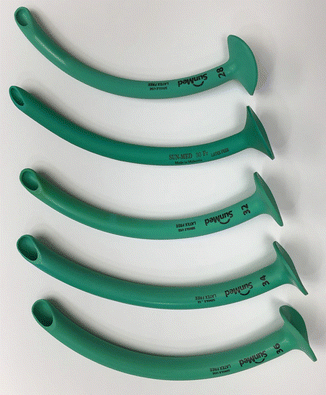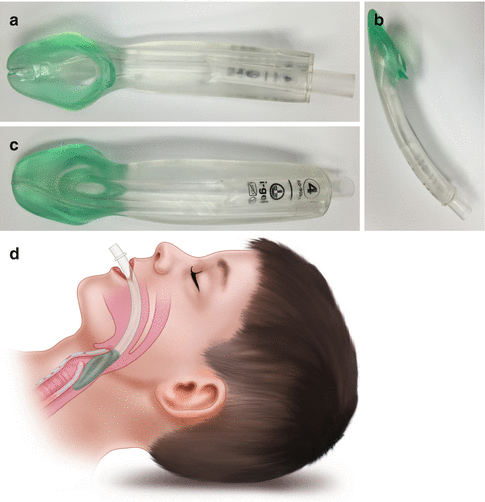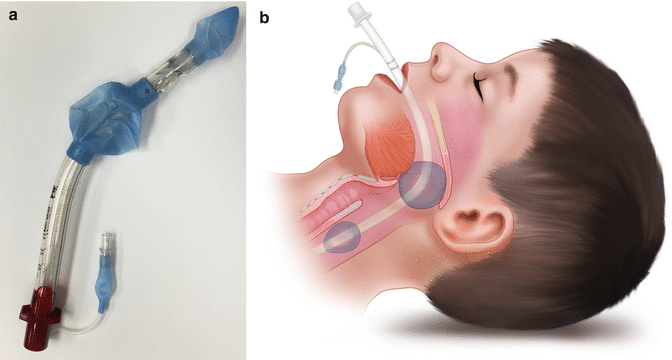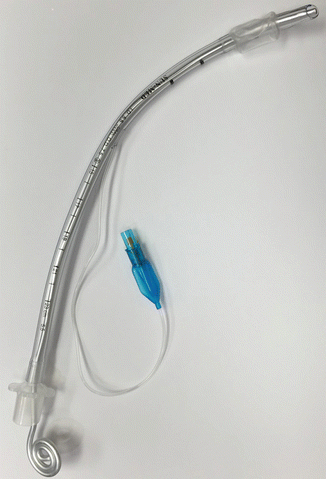Fig. 13.1
(a, b) Oropharyngeal airways, sizing and in proper position

Fig. 13.2
Nasopharyngeal airways
Various supraglottic airways can also be utilized in unconscious patients as advanced airway adjuncts and are indicated when BVM and the insertion of an oropharyngeal airway do not overcome soft tissue airway obstruction or the pressure needed to generate an adequate tidal volume is too high, such that gastric insufflation is likely. A supraglottic airway is generally easy to insert and provides a conduit for air directly to the glottic area. There are many to choose from and one commonly used type is the laryngeal mask of which various brands and designs are available. Of the laryngeal masks, the i-Gel brand does not require cuff inflation, has venting for gastric air, and does not fold at the tip. Therefore, the i-Gel may reduce tasks and ease placement such that PPV can be more rapidly provided in an emergency. Placement is generally uncomplicated, but repeated training in its use is required (Fig. 13.3). Another supraglottic airway, the King LTD, is one version of a supraglottic airway that enters the esophagus with inflatable cuffs that seal the esophagus and oropharynx. Fenestrations between the cuffs allow an attached BVM to provide ventilation to the glottis (Fig. 13.4). Although endotracheal intubation is the gold standard for securing the airway, endotracheal tube insertion is generally not in the skill set of the pediatric dentist (Fig. 13.5).




Fig. 13.3
(a–d) i-Gel laryngeal mask top, bottom and side views and laryngeal mask in position

Fig. 13.4
(a) King LTD and (b) King LTD in position

Fig. 13.5
Endotracheal tube with stylet
The AAPD recommends drugs and equipment that should be available in pediatric dental offices for both medical- and sedation-related emergencies. Significant latitude is allowed for individual practitioners, however. Tables 13.1, 13.2, and 13.3 list recommended AAPD medical emergency drugs as well as sedation emergency drugs and equipment listed in the 2007 Joint American Academy of Pediatrics (AAP)/AAPD Guideline for Monitoring and Management of Pediatric Patients During and After Sedation for Diagnostic and Therapeutic Procedures [9] that can be modified based on provider training, skill, and practice. According to the Joint Guidelines, “The choice of emergency equipment may vary according to individual or procedural needs.” Therefore, Tables 13.4, 13.5, and 13.6 list what the author considers a focused and practical medical and sedation emergency kit for the pediatric dentist providing office-based oral moderate sedation based on current training standards. All of these drugs and devices may not be discussed in this chapter so the pediatric dentist is encouraged to review these tables carefully.
Table 13.1
AAPD recommended medical emergency drugs
|
Oxygen (with delivery device for PPV)
|
|
Diphenhydramine oral
|
|
Albuterol inhalation
|
|
Diazepam IV
|
|
Epinephrine 1:1000 IM
|
|
Flumazenil IV
|
|
Naloxone IV/IM
|
|
Ammonia inhalation
|
|
Syringes and needles prn
|
Table 13.2
AAP/AAPD drugs that may be needed to rescue a sedated patient
|
All AAPD medical emergency drugs and:
|
|
Atropine IV/IM
|
|
Epinephrine 1:10,000 IV/IM
|
|
Lorazepam IV
|
|
Methylprednisolone IV
|
|
Fosphenytoin IV
|
|
Racemic epinephrine (inhalation)
|
|
Sodium bicarbonate IV
|
|
Dextrose (25 or 50 %) IV
|
|
Lidocaine (cardiac/local) IV
|
|
Succinylcholine IV/IM
|
|
Rocuronium (non-depolarizing paralytic) IV
|
Table 13.3
AAP/AAPD equipment that may be needed to rescue a sedated patient
|
Intravenous
|
|
Assorted IV catheters (24, 22, 20, 18, 16)
|
|
Tourniquets
|
|
Alcohol wipes
|
|
Adhesive tape
|
|
Assorted syringes (1, 3, 5, 10 ml)
|
|
IV tubing
|
|
Pediatric drip (60 drops/ml)
|
|
Pediatric burette
|
|
Adult drip (10 drops/ml)
|
|
Extension tubing
|
|
Three-way stopcock
|
|
IV fluids
|
|
Normal saline
|
|
Lactated Ringer’s
|
|
D5W/0.45 % saline
|
|
Pediatric IV boards
|
|
IV needles/butterflies
|
|
25, 22, 20, 18
|
|
Intraosseous bone marrow needle
|
|
Sterile gauze pads
|
|
Gloves (sterile and non-sterile)
|
|
Airway management equipment
|
|
Face masks
|
|
Infant, child, adult sizes
|
|
Bag/valve/mask set
|
|
Oropharyngeal airways
|
|
Infant, child, adult sizes
|
|
Nasopharyngeal airways
|
|
Small, medium, and large
|
|
Laryngeal mask airways
|
|
1, 1.5, 2, 2.5, 3, 4, 5
|
|
Laryngoscope handle
|
|
With extra batteries
|
|
Laryngoscope blades
|
|
With extra light bulbs
|
|
Straight (Miller) 1, 2, 3
|
|
Curved (Macintosh) 2, 3
|
|
Endotracheal tubes
|
|
Uncuffed
|
|
2.5, 3, 3.5, 4, 4.5, 5, 5.5, 6
|
|
Cuffed
|
|
6, 7, 8
|
|
Stylettes and surgical lubricant
|
|
Suction catheters
|
|
Yankauer (tonsillar) suction
|
|
Nasogastric tubes
|
|
Nebulizer kit
|
Table 13.4
Author-recommended medical emergency drugs
|
Oxygen with PPV device
|
|
Epinephrine
|
|
Epinephrine auto-injector (e.g., EpiPen)
|
|
Adult 0.3 mg [2]
|
|
Pediatric 0.15 mg [2]
|
|
Or Epinephrine 1:10,000 IM [2]
|
|
Diphenhydramine
|
|
Oral 25 mg tabs and/or
|
|
Injectable 50 mg/ml IM
|
|
Albuterol inhaler, preferably with a chamber delivery device
|
|
Midazolam 5 mg/ml IM
|
|
Glucose oral
|
|
Appropriate needles and syringes for drug delivery
|
Table 13.5
Author-recommended drugs that may be needed to rescue a sedated patient
|
All recommended medical emergency drugs and
If you use opioids or benzodiazepines:
|
|
Opioid reversal
|
|
Naloxone 0.4 mg/ml (one 10 ml vial)
|
|
Benzodiazepine reversal
|
|
Flumazenil 0.1 mg/ml (four 5 ml vials)
|
|
Note: the author does not recommend you have succinylcholine or other non-depolarizing skeletal muscle relaxants
|
Table 13.6
Author-recommended equipment that may be needed to rescue a sedated patient
|
Airway
|
|
Assorted clear masks
|
|
Assorted oral airways and tongue blades
|
|
Bag/valve/mask for positive pressure
|
|
Ability to connect to 100 % oxygen source
|
|
Magill forceps
|
|
Supraglottic airway(s) (e.g., laryngeal mask such as i-Gel, King LT-Ds, assorted sizes)
|
|
Colorimetric CO2 indicator to connect to BVM
|
|
Suction
|
Stay updated, free dental videos. Join our Telegram channel

VIDEdental - Online dental courses


